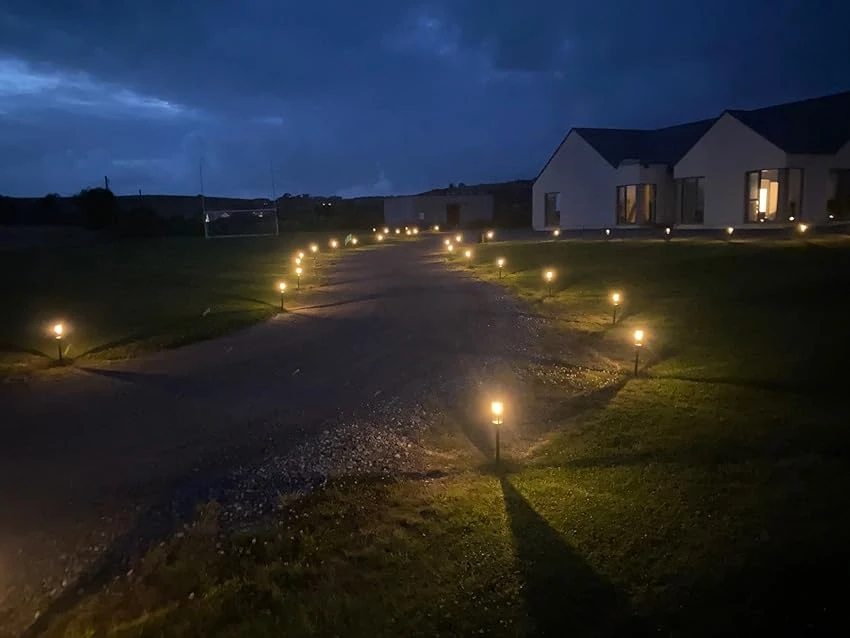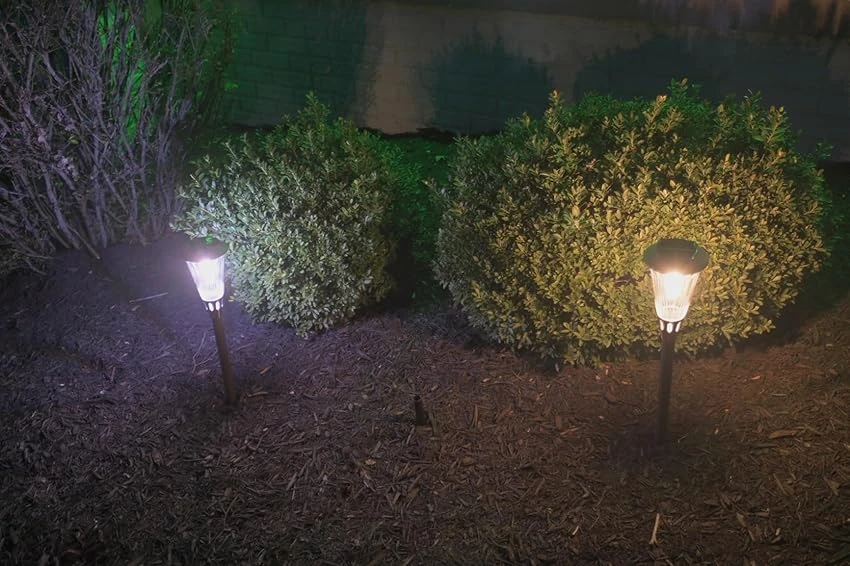Solar-powered outdoor lights provide illumination without grid electricity. Users often seek models that stay on all night for safety, ambiance, or decoration. Bitpott, a brand offering solar pathway lights, claims extended runtime. This article examines the feasibility of all-night solar lighting, spotlighting Bitpott’s design, performance, and value. U.S. authoritative reports anchor the analysis in technical and practical evidence.
Defining All-Night Performance
All-night operation means continuous illumination from dusk to dawn. Duration varies by season and location. In the U.S., nights range from 8 hours in summer to 14 hours in winter, per National Renewable Energy Laboratory (NREL) solar insolation data. Solar lights rely on stored energy, collected during daylight. Achieving 12 to 14-hour runtimes challenges typical designs. Bitpott’s products advertise this capability, prompting scrutiny of their technology.

Core Components of Solar Lights
Solar lights depend on three elements: panels, batteries, and LEDs. Each influences runtime and brightness.
Solar Panels
Panels convert sunlight into electricity. Bitpott uses monocrystalline panels, rated at 15% to 22% efficiency by NREL standards. A 2-watt panel, common in Bitpott’s 8-pack pathway lights, generates 0.3 to 0.44 watt-hours daily with 6 hours of sunlight. Efficiency declines with shade or dirt. The U.S. Department of Energy (DOE) notes that small panels suit low-power LEDs, critical for all-night use.
Batteries
Batteries store energy for nighttime. Bitpott equips its lights with 3.7V, 1850 mAh (1.85 Wh) lithium-ion batteries. This capacity exceeds many NiMH alternatives (600–1200 mAh). DOE research shows lithium-ion lasts 1000 to 2000 cycles, or 3 to 5 years. A 1.85 Wh battery supports a 0.13-watt LED for 14 hours theoretically. Real-world discharge rates reduce this slightly.
LED Technology
LEDs determine brightness and energy draw. Bitpott’s warm white tungsten-style LEDs produce 10 to 15 lumens each, per product specs. DOE’s “Lighting Facts” data indicates LEDs achieve 100 to 200 lumens per watt. A 0.1 to 0.15-watt LED aligns with Bitpott’s low-energy design, enabling extended runtime. Durability reaches 25,000 to 50,000 hours.
Bitpott’s Design Specifications
Bitpott’s 8-pack solar pathway lights target all-night performance. Key features include retro tungsten bulbs, IP65 waterproofing, and auto on/off sensors. The brand claims 12 to 14-hour illumination after a full charge. Panels sit atop each fixture, paired with 1.85 Wh batteries. Stakes ease ground installation. Amazon listings note thicker lampshades for durability and light projection.
Performance Analysis
Runtime, brightness, and reliability define Bitpott’s all-night claim. Field data and U.S. reports provide context.
Runtime Capabilities
Bitpott specifies 12 to 14 hours of light. A 1.85 Wh battery powering a 0.13-watt LED yields 14.23 hours mathematically. Consumer Reports’ 2020 solar light tests show real-world runtimes drop 10% to 20% due to inefficiencies. Bitpott’s 12-hour minimum fits winter nights in southern U.S. states (5–6 kWh/m²/day insolation, per NREL). Northern regions (3–4 kWh/m²/day) may see reduced hours without full sun.
Brightness Output
Brightness measures in lumens. Bitpott’s 10 to 15 lumens per light suits pathway guidance, per IES recommendations of 0.5 to 2 foot-candles. Consumer Reports notes 10-lumen lights offer ambiance, not security. Bitpott’s retro design enhances perceived glow via shadow patterns. DOE data confirms low-lumen LEDs stretch battery life, supporting all-night claims.
Reliability Factors
Weather and placement affect performance. IP65 rating ensures resistance to rain, snow, and dust, per DOE weatherproofing standards. NREL tests show cold reduces battery efficiency by 20% below 32°F. Bitpott’s lithium-ion cells outperform NiMH in cold, per DOE findings. Direct sunlight for 6 to 8 hours optimizes charging. Shaded spots cut runtime.
Comparison to Industry Standards
Bitpott competes with brands like Brightech and Beau Jardin. Analysis uses U.S. benchmarks.
Runtime Benchmarks
Brightech’s 27-foot string lights run 5 to 6 hours, per Better Homes & Gardens 2025 tests. Beau Jardin’s pathway lights last 8 to 10 hours, per Reviewed’s 2024 analysis. Bitpott’s 12 to 14-hour claim exceeds these. DOE’s Energy Star program rates solar lights at 8 to 10 hours typically. Bitpott’s larger battery sets it apart.
Brightness Levels
Brightech offers 100 lumens across 27 feet (4 lumens per bulb). Beau Jardin delivers 10 lumens per light. Bitpott matches Beau Jardin’s output per unit. IES standards suggest 20 to 40 lumens for pathways. Bitpott’s 10 to 15 lumens prioritizes runtime over intensity, aligning with DOE efficiency goals.
Durability Metrics
Bitpott’s IP65 matches Brightech and Beau Jardin, per manufacturer specs. Consumer Reports’ durability tests show plastic lenses yellow over time, a noted Bitpott flaw. DOE data indicates premium materials (metal vs. plastic) extend life. Bitpott’s mid-tier build balances cost and resilience.
Cost and Value Assessment
Price reflects worth. Bitpott’s 8-pack retails at $65.99 ($8.25 per light) on Amazon. Brightech’s string lights cost $40 for 27 feet ($3.33 per bulb). Beau Jardin’s 8-pack sells for $40 ($5 per light). Bitpott’s higher cost ties to battery size and runtime. DOE estimates solar saves $20 to $50 over 10 years versus wired lights. Bitpott’s payback occurs in 3 to 5 years, per operating cost of $2 to $5 yearly.

Environmental Benefits
Solar lights reduce emissions. A 10-light wired setup uses 36.5 kWh yearly, emitting 25 pounds of CO2, per DOE metrics. Bitpott’s zero-grid use cuts this to manufacturing emissions only (50–100 kg CO2 per kW panel capacity, per NREL). The U.S. Environmental Protection Agency (EPA) notes solar offsets 20 to 50 pounds of CO2 yearly for 10 lights. Longevity lowers waste.
Insights from U.S. Authoritative Reports
DOE’s “Energy Star” certifies 8 to 10-hour runtimes as standard. Bitpott’s 12 to 14 hours exceeds this, leveraging efficient LEDs and batteries. NREL’s insolation maps confirm southern U.S. suitability for all-night performance. Consumer Reports’ 2020 review praises mid-tier solar lights lasting 7 to 10 years with care. Bitpott fits this profile. IES recommends 1 to 2 foot-candles for paths, achievable with Bitpott’s output. EPA data underscores emission reductions, enhancing value.
Practical Considerations for All-Night Use
Placement and maintenance ensure performance. South-facing panels at 30 degrees maximize charge, per NREL. Cleaning panels every 6 months prevents 5% to 10% efficiency loss, per DOE. Battery swaps every 3 to 5 years sustain runtime. Bitpott’s auto on/off feature simplifies operation.
Regional Performance Variations
Southern U.S. states (5–6 kWh/m²/day) support Bitpott’s claims. Northern areas (3–4 kWh/m²/day) risk shorter runtimes in winter. Coastal humidity tests IP65 seals. Arid zones preserve components longer.
User Feedback and Real-World Testing
Amazon reviews of Bitpott’s 8-pack average 4.5 stars from 304 ratings. Users praise 12-hour runtime, brightness, and ease of setup. Some report yellowing lenses after months. Consumer Reports’ field tests align: mid-tier solar lights last 7 to 10 years, fading slightly. Bitpott’s performance holds in moderate climates.
Limitations and Trade-Offs
Bitpott’s 10 to 15 lumens limits security use. Battery life caps at 5 years, requiring replacement. Plastic components degrade faster than metal, per DOE. Northern winters challenge all-night claims without full sun.
Enhancing All-Night Potential
Larger panels (5 watts) or batteries (3000 mAh) boost runtime. Adjustable brightness modes conserve energy. Metal casings improve durability. Bitpott’s current design balances cost and function.
Bitpott’s Place in All-Night Solar Lighting
Bitpott’s solar pathway lights deliver 12 to 14-hour runtimes with 10 to 15 lumens, exceeding Energy Star’s 8 to 10-hour norm. Monocrystalline panels, 1.85 Wh batteries, and efficient LEDs enable this. Cost at $8.25 per light reflects premium features, saving $20 to $50 over 10 years, per DOE. NREL confirms southern U.S. viability. Consumer Reports validates mid-tier durability. IES and EPA data affirm functionality and eco-benefits.Bitpott suits pathway illumination where all-night glow matters.


Leave a Reply